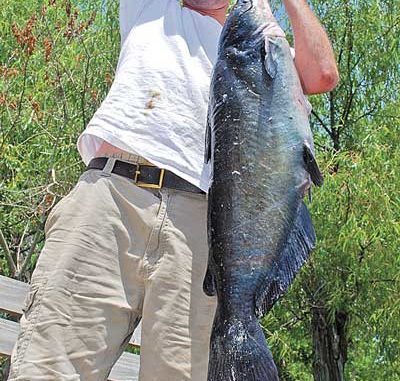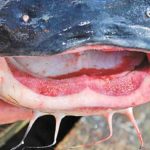
This perennial Black Bay hotspot is producing big trout and reds.
Seldom do anglers associate “freshwater” and “big-game fish” together. But Louisiana, with the continent’s largest rivers, large and small lakes and reservoirs, vast freshwater marshes and seemingly endless miles of small rivers, bayous and streams, is home to several species of large freshwater fish.
Included in that number are the alligator gar, the Atlantic sturgeon, the flathead catfish and the blue catfish. All attain weights of over 100 pounds.
Alligator gar have become uncommon in most Louisiana waters except in its fresh and brackish marshes. Atlantic sturgeon are uncommon, are restricted to the rivers of the Florida Parishes and are protected.
Both flathead and blue catfish are fairly common, however. The official Louisiana state records are 95 pounds for a flathead catfish caught from Wax Lake by Roland Lasseigne in 2007 and 110.19 pounds for a blue catfish caught by Keith Day in the Mississippi River near St. Francisville in 2005.
Both species produce whoppers, but blue cats run bigger. The bottom fish in the Louisiana top-10 records for both species illustrates this. For flatheads, it is a 26.13-pounder and for blue catfish it is a 69-pound fish.
If historical records, rather than official records, are to be believed, blue catfish can grow to truly stupendous sizes. In 1879, J.G.W. Steedman, chairman of the Missouri Fish Commission found two blue catfish weighing 144 and 150 pounds in a St. Louis Fish Market. He bought the larger one, and sent it to the U.S. National Museum.
Constantine Rafinesque, an early naturalist who was exploring America, wrote in 1820 of catfish weighing 185 and 250 pounds. Another naturalist P.R. Hoy wrote from Missouri that in May 1854, “A lad caught on hook and line today a catfish weighing 136 pounds.”
A news report in 1862 said that many blue catfish weighing between 200 and 300 pounds were being caught near Yankton, S.D., undoubtedly from either the Mississippi or Missouri rivers. Finally, a 315-pounder was reported just after the Civil War from Morrison, Mo.
All blue cats, no matter how big they get, start out by being spawned in a protected nest, almost always in some sort of cavity. Natural cavities, such as undercut banks, hollow logs and cavities under tree root-wads are heavily used, as is debris, such as metal drums and so forth, that have been discarded or lost by humans.
As springtime water temperatures near 70 degrees, male blue catfish begin to “clean out” the cavity. They are so assiduous that they will scour the inside of a metal 55-gallon drum until it is smooth and shiny. Spawning does not begin until water temperatures reach at least 70 to 75 degrees.
After spawning, the males will drive the females away from the nest and begin to guard the young. Intruders, including human hands, can be bitten. For six to 10 days, the male will fan the sticky mass of fertilized eggs with his fins, keeping oxygenated water flowing over the eggs and silt off of them.
For a few days after hatching, the young catfish will remain in the nest cavity, and the male fish will continue to guard them. After they absorb their yolk sacs, the young will disperse, and the male will leave the nest.
During spawning season, blue catfish exhibit little interest in feeding. Males will not eat at all during the spawning and egg-guarding period.
In Louisiana, males mature on average at age-4 and about 19 inches long. Females do not mature until age-5 and about 24 inches long. One-year-old fish are about 6 inches long and 2-year-olds average 11 inches long.
Blue catfish can live at least 25 years, and will continue to grow throughout their lives. In truth, very little is scientifically known about the fish in the topside of its life span. Most recreational freshwater fishing tackle gives way quickly to the massive weight and strength of fish over 40 pounds.
Large fish are not susceptible to most scientific collecting gear either and, of course, large blue catfish are less common than are smaller sizes. Few end up being available for scientists to study.
Small blue cats primarily eat invertebrates such as insects, crawfish, grass shrimp, river shrimp, clams, worms and some plant matter. As they grow larger, they feed more and more upon living fish and other larger creatures. In the Louisiana coastal marshes, it is not uncommon to find parts of nutria and other mammals in their stomachs.
The reputation that freshwater catfish have of being scavengers is unfairly applied to the blue catfish and its first cousin, the flathead catfish. Both are strong fish predators. While the flathead is an ambush predator, blue catfish are aggressive and actively hunt for fish.
The large tooth pads in the upper and lower jaws of blue catfish have surprisingly rough teeth, and the jaws can exert a vise-like grip on whatever gets in their mouths. Fishing for trophy blue catfish as a big-game fish almost always demands the use of live or freshly killed fish, and the fish used for bait can be surprisingly large, often over a pound in weight.
Blue catfish avoid low-oxygen environments. They are known as fish of big rivers, like the Mississippi, Atchafalaya and Red. The top-three blue catfish and four of the top 10 fish in the Louisiana record books came from the Mississippi River, and a fifth fish came from the Old River Locks between the Mississippi and Atchafalaya. One fish each came from the Atchafalaya River, the Red River and the West Pearl River.
Not until fish No. 10 in the list did a fish come from a lake, and that lake was Lac Des Allemands, a marsh lake.
Louisiana’s freshwater marshes are the most overlooked locations in the state for fishing for big-game blue catfish. Weights of freshwater marsh blue cats will often top 25 pounds, and for skilled anglers using live bait, a 10-pounder is considered
small.




